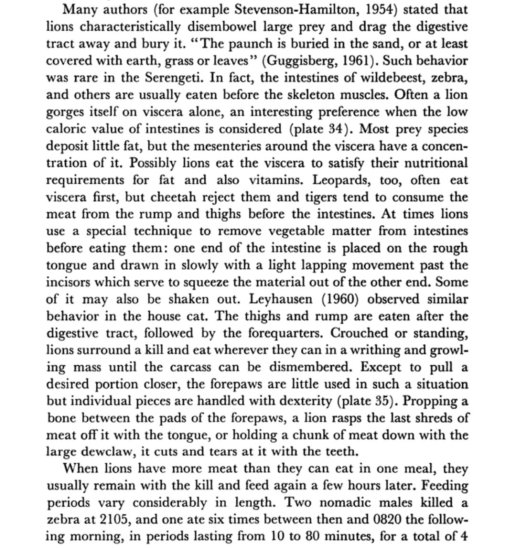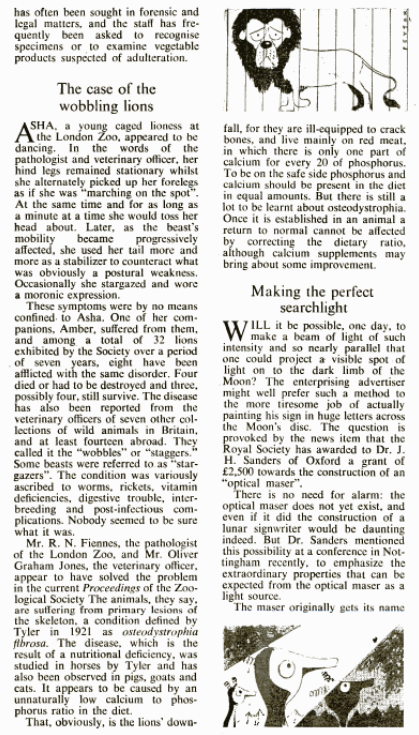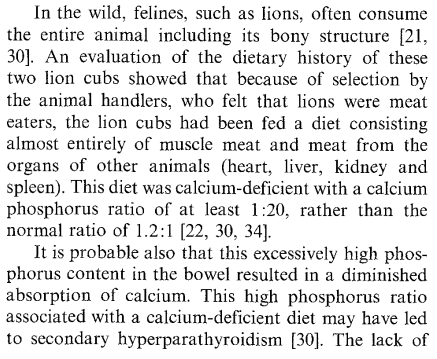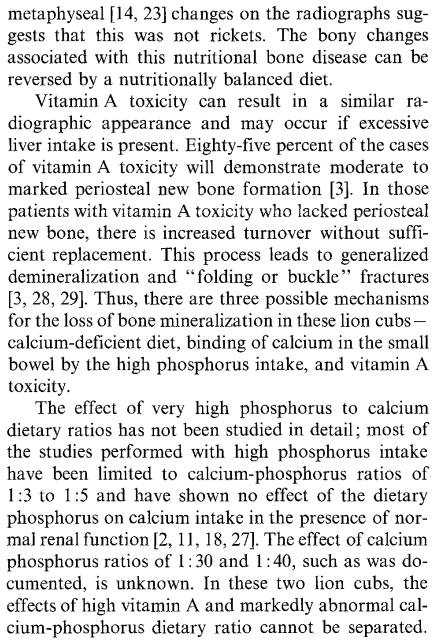Do lions eat the organs of their prey, or can a lion survive only on muscle meat? I’ve seen this question asked online but clear answers are hard to find, at least not answers with sources backing them up. In an attempt to answer that question online I found that lion nutrition is an interesting topic, and this is the result of my intrepid Googling.
TL:DR Captive lions suffer serious nutritional deficiencies if fed only muscle meat. Lions preferentially eat the intestines and organs of prey animal, continuing to eat virtually everything else including some bones. Those organs and bones are essential to provide the vitamins and minerals required for good lion health.
The book The Serengeti Lion: A Study of Predator-Prey Relations by George B. Schaller gives a description of the feeding practices of the lions of the Serengeti. Very little of the animal is left uneaten by the lions.

The book goes on to say that the lions often gorge themselves first on the gut and internal organs first, suggesting a preference for the internal organs of the body, perhaps due the importance of these to their nutritional requirements in providing both fat and vitamins found in and around the gut.

Husbandry Guidelines for the African Lion by Annemarie Hillermann also provides some interesting details as to the nutritional requirements for lions. Perhaps unsurprisingly, feeding lions whole animal prey to eat is recommended as the simplest way to provide a balanced nutrition and diet for lions.

These guidelines go on to describe how obesity is a potential problem in captive lions. Given their sedentary lifestyle in captivity their food must be restricted to meet their needs, if given too much they will overeat. Additionally, starve days are recommended to mimic their natural feeding frequency.

ZUTRITION, another great source of information, has some comprehensive advice regarding the nutrition of lions.
“Cats are obligate carnivores. They derive most of their energy requirements from protein. The natural diet of cats is rich in proteins and therefore cats had no evolutionary need to synthesize as many amino acids as omnivores did. They have an absolute requirement for protein, and cannot synthesize the amino acids taurine, arginine, methionine and cystine. Meat diets will provide these amino acids, however diets that contain more carbohydrates may be deficient.
All-meat diets pose potential problems, however. A calcium:phosphorus ratio imbalance may lead to growth problems or metabolic bone disease. The Ca:P ratio in the body is 2:1. The Ca:P ratio to aim for in the diet is between 1:1 and 2:1. All-meat diets are high in phosphorous and have little-to-no calcium. They also may be lacking in vitamins A, E and D, which are found in adipose or organ tissues.
Vitamins B and K are provided by gut contents of whole prey and would be lacking in an all muscle-meat diet. Organ meats such as liver, kidney and heart tend to have the worst ratios of Ca: P and may run as high as 1:44.”
ZUTRITION has the following advice captive lion nutrition and the potential for nutritional deficiencies.
Lions seem to have a high requirement for preformed retinol (Vitamin A) and need a regular source of liver to supply this, particularly in young lions.
“Vitamin A deficiency has been implemented in causing abnormalities in the cranial bones, especially atlanto-occipital malformation with ankylosis, hypertrophic osteopathy in the occipital bone and parietal bone, and osseous tentorium cerebelli, leading to progressive ataxia in young lions. Most affected lions are between 6–15 months of age. Many of the lion cubs exhibiting this syndrome were fed a diet of chicken parts with little other supplementation.”
Thiamin deficiency can also occur, as also noted in this study, as lions have a high requirement for B vitamins.
“Vitamin B1 (thiamin) deficiency has caused anorexia, ataxia (more pronounced in the rear limbs), hypermetria (more pronounced in the front limbs), progressing to generalized weakness and recumbency lasting several minutes to hours, or longer. Young lions presenting with this problem were often fed a beef muscle meat diet supplemented with calcium.”
Feeding lions a diet of chicken meat can also result in severe copper deficiency, also noted in this study in the United Arab Emirates where lions and other big cats are often kept as pets.
Copper Deficiency can result from feeding a diet almost exclusively comprised of poultry. This deficiency results in ataxia.
An imbalanced ratio of phosphorus to calcium, from feeding only meat and organ meats without any bones, is now understood to cause metabolic bone disease in lions. If an all muscle-meat or a muscle and organ meat diet is fed, the diet must be supplemented with some form of calcium.
“Metabolic bone disease (MBD) may result from feeding a diet with an inappropriate calcium: phosphorus ratio. The calcium should be approximately 1.7 times the phosphorus in the diet. Organ and muscle meat are very high in phosphorus and calcium must be supplemented in appropriate amounts to prevent this problem. Thin bone cortices as well as hairline fractures and intermittent lameness are all signs of metabolic bone disease.”
It appears that big cats require a substantial amount of calcium from bone consumption to balance out the phosphorus in the meat and organ heavy diet.
“Private owners often feed poor diets such as ground turkey meat or chicken breast to young growing cubs. They fail to supplement the cubs with sufficient calcium (see Calcium Supplementation chart above), and the cubs they hand-rear suffer terrible consequences. It takes about 12 GRAMS of calcium carbonate to balance one kilogram of muscle meat fed.”
The effects of this imbalanced calcium to phosphorus ratio in lions was noted early on in 1960 in a rather sad news article in the New Scientist magazine as the cause of a long-standing problem in captive lions.

Source: From New Scientist magazine, 12th May 1960.
A paper titled Nutritional and metabolic bone disease in a zoological population was published in 1976 detailing the health of two lion cubs suffering from multiple bone fractures and thin under-mineralised bones. This was attributed to them being fed a diet of muscle meat and offal, lacking in bones. As meat is high in phosphorus compared to calcium a high ratio between these minerals was suspected as causing these bone problems, although vitamin A poisoning could not be ruled out.


(Source)